Baitball Underwater Photography
By Allen Walker
In essence, baitball photography is just good ol’ underwater photography at a frenetic pace with an added punch of adrenalin. It’s hard not to be a bit excited when you’re in the midst of thousands (or millions) of schooling fish being hunted by top apex predators such as sharks, dolphins, whales, salfish, and birds.
But that is the monster you really have to overcome—adrenaline. The rest is planning, equipment, muscle memory, and composition—the latter being the most difficult based on the subject matter and the environment you are working in.
Baitball Photography—Avoiding the Adrenaline Rush
So why is adrenalin a bad thing? After hundreds of discussions with fellow photographers after a day out on the ocean where they have been lucky enough to find a baitball, the same old “monster” shows itself in all the stories of their trials and tribulations. “I forgot my weight belt and could not get down.” “I forgot to check the manual strobe buttons.” “There were bubbles on the dome port.” “My camera would not focus.” All of these problems arise because, when the moment takes over us, the adrenalin kicked in and we forgot to do all the things we would normally do when taking wide-angle images in a calm environment.
The advice in this article to help overcome such challenges and come home with amazing images from an equally amazing situation is based on countless dives on South Africa’s “Sardine Run.” But I am pretty sure these same tips can be applied wherever you may find and photograph a baitball. It’s all about the principles.
Baitballs are arguably the most exciting wide-angle underwater photo opportunity you will ever encounter, and with a little guidance you can produce jaw-dropping results
Diving Equipment for Baitballs
That your dive gear is an important factor will often be overlooked by most aspiring underwater photographers. Yet your diving equipment will make or break your chances of getting the images you have been waiting for, and possibly result in the loss of the only opportunity you will ever get. You need to have dive gear you’re 100 percent familiar with, to the point you don’t need to think about making any adjustments on the fly—even when the baitball dips down to 150 feet or more.
First and foremost, make sure that your equipment is working and suitable for the task at hand. It should also not be cumbersome and finicky to put on and take off. Time is a luxury you do not have. Most operators also do not have people on the boat helping you put your gear on, and normally there is such a rush to get to the location where the action has been spotted that by the time you get there, all you should be doing is sliding over the side with your camera in hand.
Having a successful baitball dive begins and ends with dive equipment that is familiar, comfortable and functional
- Mask and Snorkel: Always have a spare mask and snorkel, preferably a low-volume mask. Keep it in a hard case or your camera box—the action can get crazy and you don’t want a mask over the side of the boat to ruin your day (or trip).
- BCD: It must be light and minimalistic. You don’t want something cumbersome and laborious when the moment to get ready arrives.
- Weights: Do not use integrated weights if you use more than 8 lbs, as they become impractical for this application and take too much time. A weight belt is a quicker solution when you’re hopping in and out of the water.
- Fins: If possible, use closed heel fins with neoprene socks. They are faster to put on, more powerful, and more durable in tough conditions.
- Regulator: Streamline your regulator and make sure you have removed all unnecessary bells and whistles such as bungee cords or loops.
- Tank: If the tank choice is in your hands, a small six- or seven-liter 200- or 300-bar (U.S. equivalent) cylinder is the most ideal for a setup suitable for photographing events like the Sardine Run because of its compactness. You’ll be near the surface most of the time—so there’s no need for a lot of air.
Having a streamlined setup will allow you to focus more on your photography and less on adjusting your dive gear
Underwater Photography Equipment for Baitballs
When selecting the type of equipment you buy, most of us do a lot of research into what is considered the “best your buck can buy.” However, when photographing high-paced, fast-moving action, it helps to have the best equipment for the job. Here are my recommendations for deciding what photo gear to buy and bring for diving baitballs.
Camera and Housing
The two most important factors for camera selection are the frame rate and autofocus ability. To have the best chance of capturing dramatic underwater action, your camera should be able to rattle off at least five frames per second in continuous mode. Having a fast, accurate autofocus is a must when the water is swarming with dozens of predators and often clouded by floating debris. For this reason, while compact and mirrorless cameras can be used for baitball imagery, their often-inferior autofocus will leave shooters at a disadvantage.
As far as housings goes, the more durable the better. Your housing should be able to take being knocked around the boat in rough conditions, be bumped by feeding predators, and anything else the baitball can throw at it. Ideally, your housing should have leak detection and a pressure system to confirm it’s sealed. This is not a call for you to go out and buy top-of-the-line kit, but having a housing that can take a hit or two will allow you to focus on the photography, not your camera’s well-being.
I prefer to have a housing that offers both optical and electronic strobe connections. This allows more shooting options, and also the ability to switch to fiber-optics should the worst happen and your electronic strobe connection fails. Finally, consider purchasing buoyancy floats for the camera that produce neutral buoyancy at 30 feet underwater, your most frequent working depth. The strain of a heavy camera system is something you can ill afford in these conditions.
Having a durable dive housing is definitely a plus in an environment where you can get rammed by sharks, dolphins, birds—or all of the above
Lenses and Ports
This can be a tricky decision when photographing baitballs, as you want a wide-angle lens, but sometimes you also want to try and get some tighter shots with longer focal lengths. I have found that a fisheye zoom lens is best for a cropped-sensor DSLR, while a rectilinear wide-angle zoom is a great tool combined with a full-frame DSLR.
There is no singular recommendation for choosing a port, but a good-quality mini glass dome port will let your camera quickly lock onto the subjects, without creating the drag of a larger port. Having said that, baitballs are also a great opportunity to capture split shots—so bring your big dome along as a second option.
Go for the fisheye: Using a wider-angle lens will allow you to fit more of the action into the frame. For full-frame DSLRs, you may opt for a rectilinear zoom lens
Strobe Setup
It is pointless bringing a camera that can fire bursts of 10 frames per second, but packing strobes that can only fire every five seconds at full power. You will need to consider the recycle times of your strobes at their various power levels and then see if that matches your camera’s capabilities—or at least comes close to it.
While having a fiber-optic strobe connection is a good backup, electronic cables are the preferred choice for baitball photography. First, they will allow you to rapid-fire without having to wait for the camera’s pop-up flash to recycle. Second, I have witnessed many underwater photographers having to plug the fiber-optic cables back into the plugs when bumped—not something you want to worry about in the middle of a baitball. As for your strobe arms, keep them simple and short. Long, multi-jointed strobe arms become very cumbersome when trying to get on and off the boat multiple times.
Using an electronic strobe connection is a must to allow your camera and strobes to quickly rattle off a sequence of images in a matter of seconds
Memory Cards
People spend a ton of money buying and packing state-of-the-art cameras, housings, and lenses, only to buy cheap memory cards. This is the worst equipment move you can make! Ensure your memory cards’ write speed is equivalent to, if not faster than, the write speed of the camera. This will ensure that your buffering time is minimal and that the number of images you can take consecutively is at its maximum.
Finding Baitballs to Photograph
Birds are most probably Nature’s best source to use when trying to track down baitballs. They normally flock to the area of activity in large numbers in the hopes of getting some of the food that has been herded close to the surface by the predators.
In a lot of cases, dolphins assist as well: When they start moving and hunting, you can pick up on the energy, and stay with them, but keeping your distance so that you do not interfere or impact the hunting process. It’s best to give the dolphins time to corral the baitball, and only once it is truly formed should you slide into the water from about 25 feet away.
Some operators use airplanes and helicopters to help track down baitballs over large swathes of ocean. This is perhaps the most accurate method, but it is also the most costly. Water turbulence is another key thing to look out for in any marine environment: Sometimes the birds have not spotted the formed baitball and these balls normally evolve into long-lasting baitballs that can continue for hours.
Birds are often the best sign of a baitball. Even if you’re not looking for one, a crowd of birds on the surface of the water might be a good spot to check out
Getting in the Water with a Baitball
Your success getting close to the baitball begins before you dive in: Always try and sit in the front or the back of the boat, as this will give you the most space to back roll in with a large camera and allow you to get away from other divers quicker. If there are fewer than six people on the boat, then the best thing to do is to get everyone to agree on their spots and keep it that way for the duration of the trip. Familiarity with your space is a key factor when you have to get things in and out of the water.
1. Keep your wetsuit on at all times.
2. Keep your weight belt and fins on when possible action is brewing.
3. Stay hydrated: You sweat a lot under your wetsuit without realizing it, and drinking water will keep you sharp.
Once in the water you have the first opportunities to get photographs as all the other divers will still be trying to get their gear on. During this time you will probably see the most, and your images will be free of divers and bubbles. As more divers join, smaller baitballs usually dissipate as the predators are blocked off by the divers and the baitball is now free to escape.
If you join a baitball that was found by another operator, remember that everybody in the water that was there before you and everyone that is allowed into the water after has equal rights to film or photograph this baitball. Be courteous and allow everyone an opportunity. Do not hog all the action!
A few other key elements of etiquette can go a long way to making everyone’s trip a success both in and out of the water. This all starts by keeping your gear (all of it) in your designated space: Letting your gear float all over the boat will surely irk other photographers. Shooting baitballs usually requires long days on the water, so having a sense of humor and being patient with other photographers goes a long way—not only for making the day seem shorter, but also helping to reduce stress and produce better images.
The action can be overwhelming, so it’s important to monitor depth at all times. Also consider proper etiquette with other photographers going for their shots
Staying ready to go at a moment’s notice can make all the difference between getting the shot and going home empty-handed
Baitball Underwater Photography Tips and Techniques
Drop in Ready: When you drop into the water, your camera must be ready to go with settings you know will work with general conditions. For example, in temperate/tropical waters, I typically jump in with my camera set on to 1/200s at f/9 (ISO 320) with strobes at quarter power. With this you can now work with a very basic principle I use when photographing any fast-moving action: Keep as many constants in your settings as possible and only make small changes when time permits.
Continuous Shooting: Shoot in multi-shot, AI Servo AF (Canon) or AF-C (Nikon) mode and in bursts of four shots when using more-compact strobes, which will result in so-called “natural bracketing.” The first shot will be slightly overexposed, the second and third correctly exposed, and the last slightly under.
Using the continuous shooting mode will increase your chances of capturing a perfect moment amidst the high-speed action and predation
Review Carefully: If you need to make necessary changes to your settings when reviewing, you should do this without losing sight of the baitball. Once you take your eye off the baitball, it is extremely difficult to find it again without going up to the surface—and more importantly, you will miss the shot. Keep your head on a swivel. It’s best to shoot two to three bursts, then review, and repeat. While following the baitball, your depth can fluctuate markedly, thus affecting the light tremendously. You therefore need to adapt your camera settings constantly.
Shooting from the Hip: Knowing your camera and where to position it when taking the shots is another important skill to learn. The vast majority of the shots you’ll take will be “from the hip,” while trying to keep up with the baitball. With baitballs you do not have time to set up the shot for a perfect composition, rather you need to be able to recognize the peak moment of the action and capture it. This is a volatile and energy-driven environment: Draw on that energy and let it inspire you to create magic.
You don’t want to spend too much time with your head in the viewfinder or reviewing images: The baitball moves fast and even a few seconds could cost you an opportunity
Wipe Your Dome: Remember, there are lots of bubbles, scales and particles in the water, so constantly wipe the dome port to ensure it is free of debris. If you do not, your camera will have extreme difficulty focusing on the actual subjects rather than what’s on your dome.
Careful with GoPro: If you are part of the increasing number of photographers bringing action cameras down on a stick, it’s important to not let the length of this stick override your natural respect and regard for these powerful predators. Furthermore, respect your fellow underwater photographers by making sure to avoid sticking your GoPro stick in the middle of their otherwise amazing shots.
Baitballs often bring a lot of bubbles, so remember to occasionally wipe your dome to allow your camera’s autofocus a better chance of locking onto the subject
Final Thoughts
Over the years, I have learned from all of my trials and tribulations. From year to year my images have gotten better and better, but this not only because I spent time in the water. Rather the key to capturing great baitball images is to be curious, ambitious, and to listen to advice from fellow photographers who have “been there, done that.” So take my advice and use what you need to make you a more passionate and successful photographer. This guide is what it is—purely a guide.
RELATED CONTENT
Featured Photographer

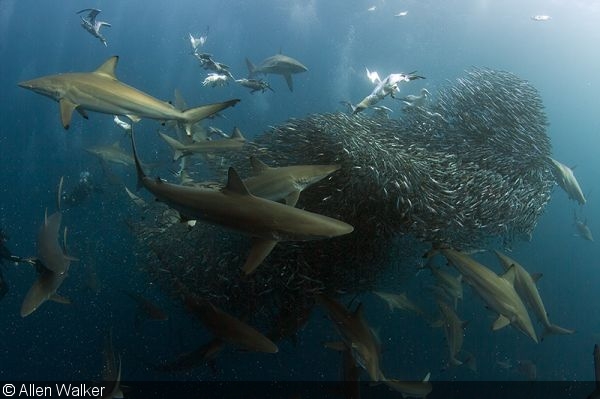
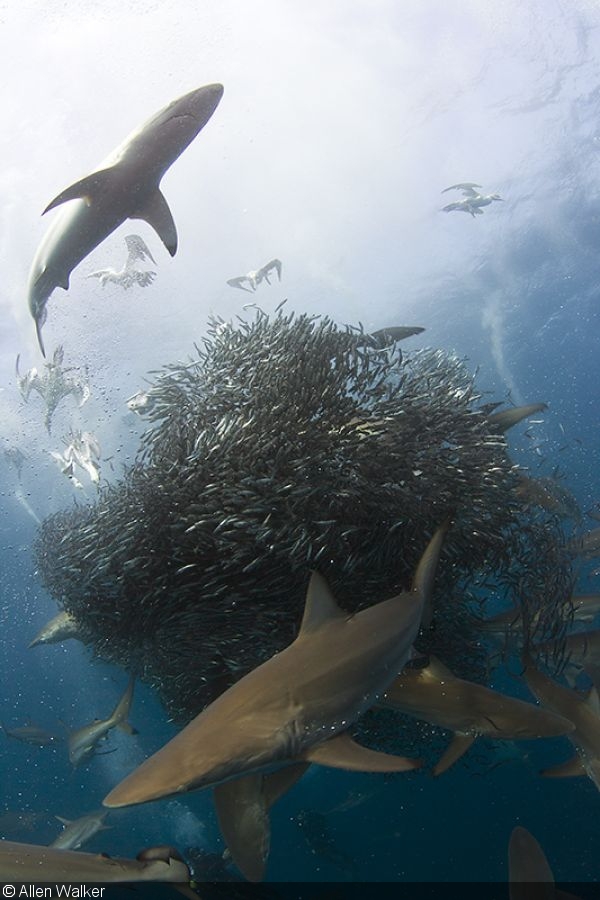

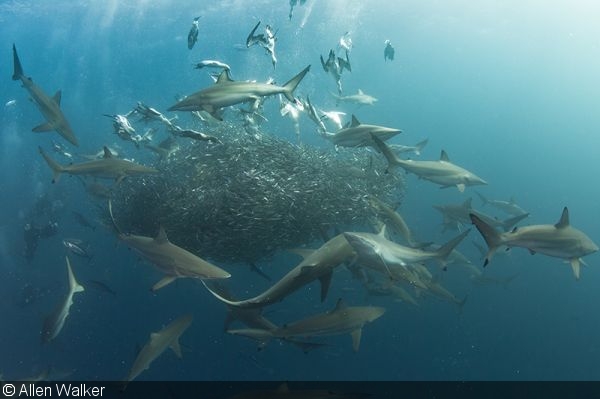
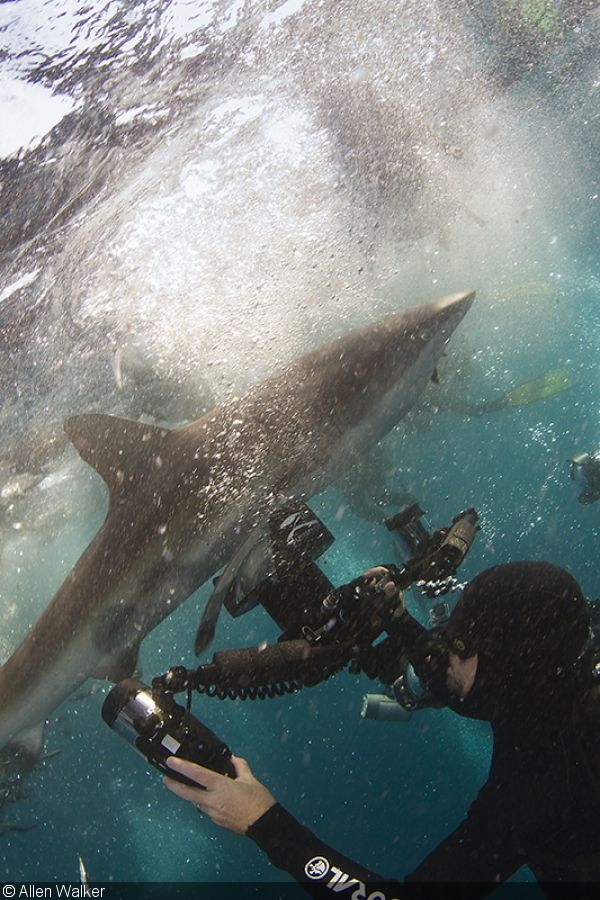
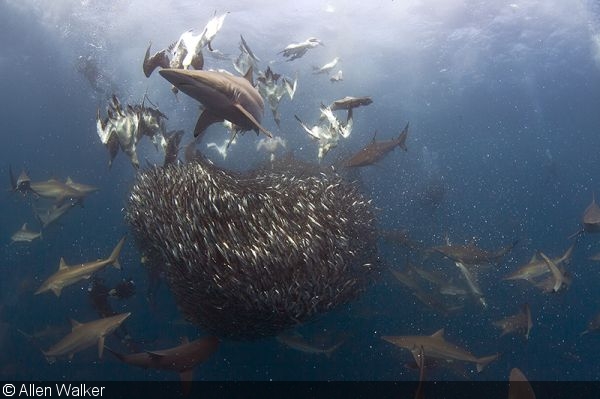
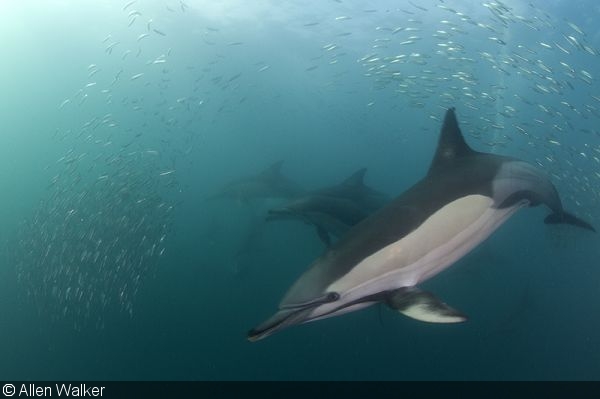
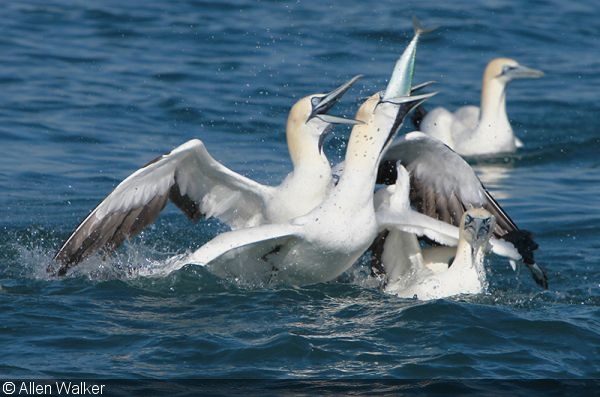

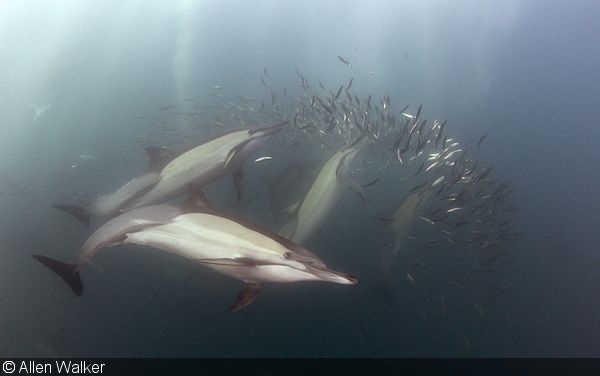
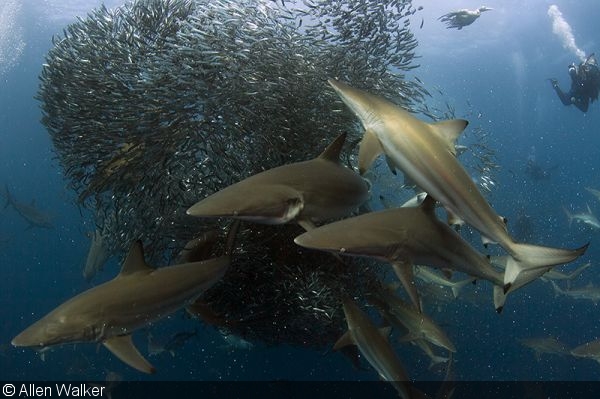
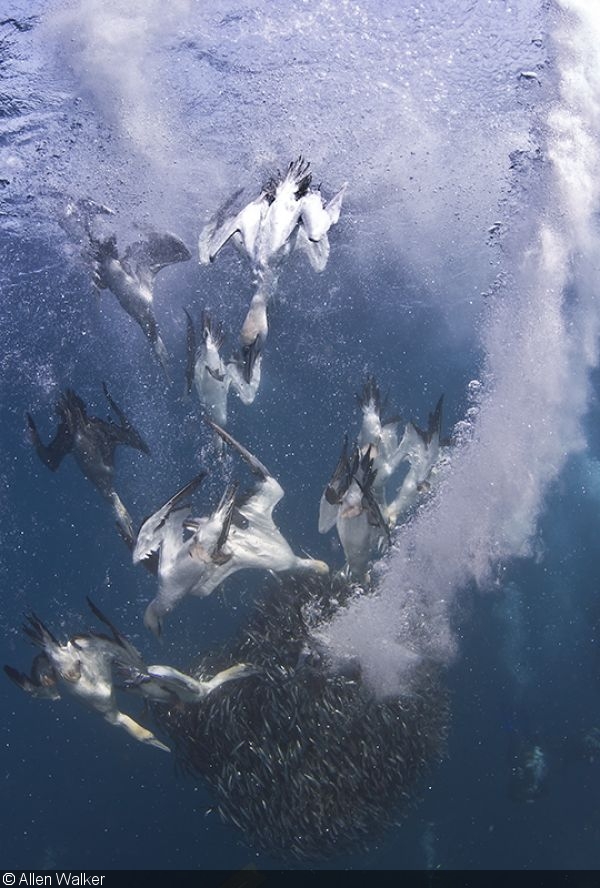
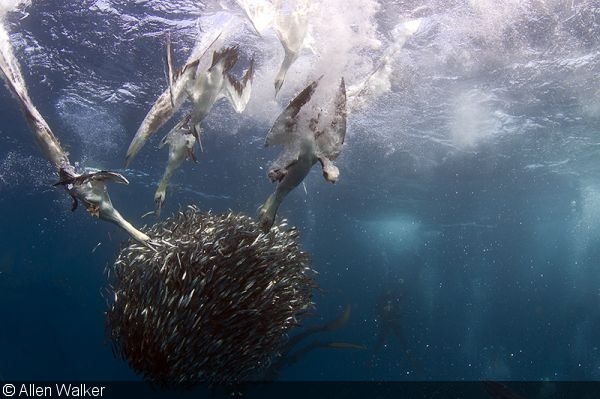
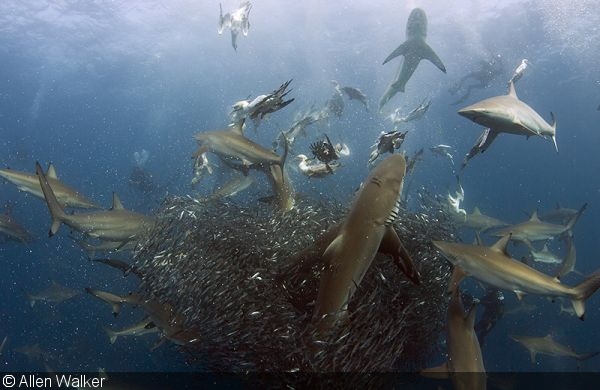
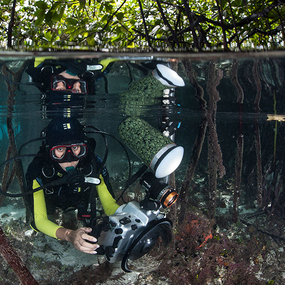
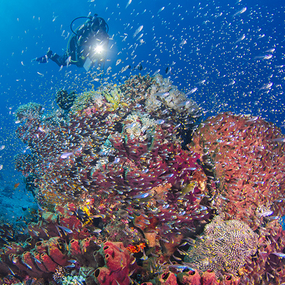
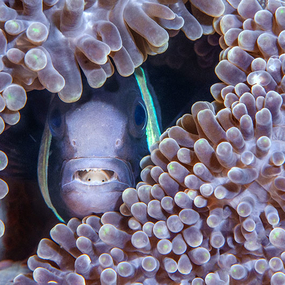
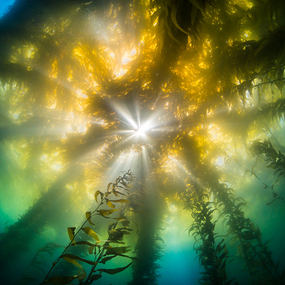
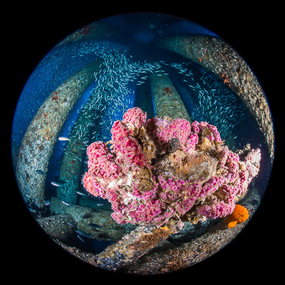
 Antarctica
Antarctica




